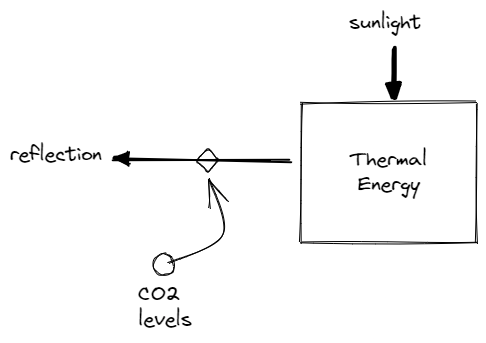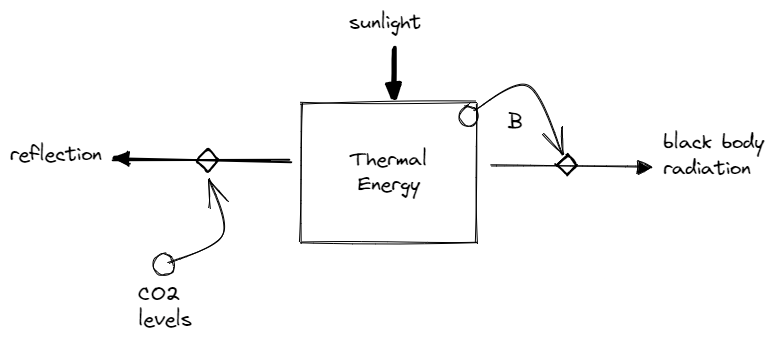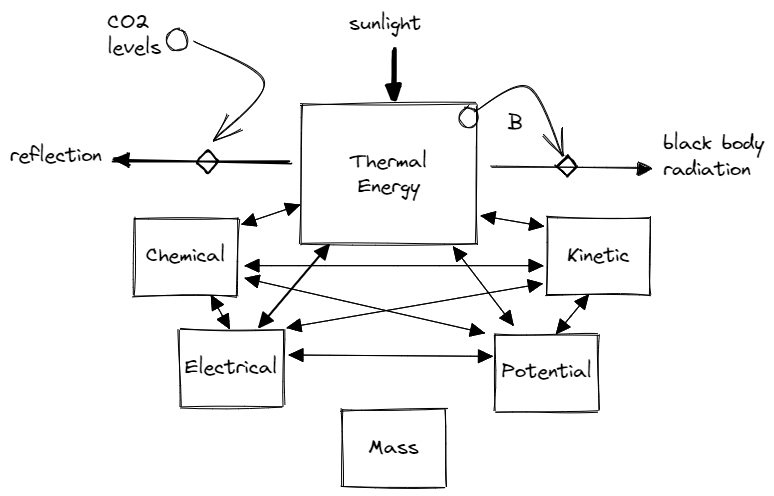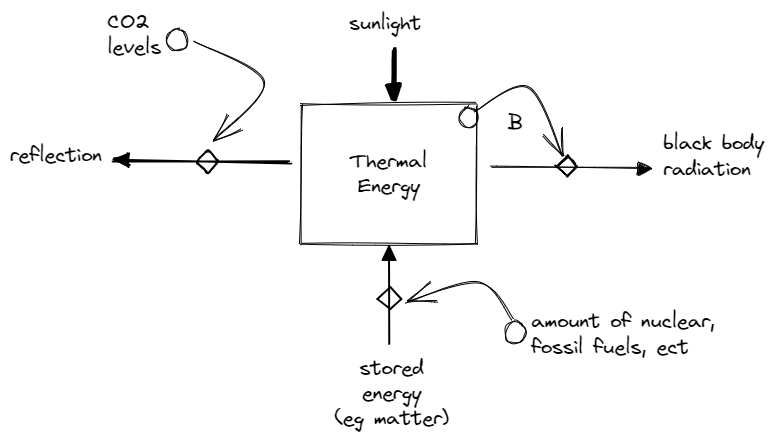Nuclear Power Steelman
In this article I explore what I believe is the strongest argument against the use of nuclear power (both fission and fusion!). To be clear, I do not think this argument means we shouldn’t expand our nuclear based power production (and will expand on why later on).
The basis for this argument is not one of the traditional concerns such as safety, storage of toxic waste, costs, or fuel acquisition. Rather, what I believe is the strongest argument is one of global waste heat managment.
Introduction
Let’s back up for a minute. The current climate narrative is heavily focused on the CO2 concentration in the atmosphere. However, CO2 concentration is not the direct cause of the climate crisis, but an indirect one. The direct cause is an increasing level of global thermal energy (ie it’s getting warmer). CO2 (or greenhouse gases more generally) are not inherently hot of course, but they cause a reduction in how much sunlight can be reflected back into space. The earth is getting less shiny.
We can model this system with a Stock and Flow diagram. In this type of diagram, boxes represent “stock”. Think of a bath-tub that can hold (“stock”) an amount of water. Arrows represent “flows”. Think of the faucet and drain of the bathtub as the flows. If more water is coming out of the faucet than is existing via the drain, the “stock” will increase.

A roughly fixed amount of sunlight hits the Earth each day, shown as an input arrow to the “thermal energy” stock. A somewhat smaller amount is reflected, shown as an arrow away from the same stock. In addition, we see that the CO2 concentration is a “determinant” to the reflection flow; a change in CO2 will change how much energy is flowing as reflection.
If this was the full picture of the system at play here, then we should be expecting the stocked thermal energy (ie the temperature) to increase each and every day. After all, there’s more energy arriving via sunlight than is being reflected… so the total stocked energy must be increasing right? We’re never going to reflect more light than what is shining on the earth! Luckily this is not the full picture, we’re missing an important element: black body radiation.
In physics, we cannot continuously increase the temperature of something by injecting a constant amount of energy per unit of time. For an intuitive example think of putting a pot of water over a small flame. We are injecting a constant amount of energy, yet the water may never reach a boil, it somehow reached an equilibrium temperature. In the case of water in a pot, it will be transfering the heat into the air and doing so at a faster rate the hotter it gets.
This same principal holds even for objects in a vacuum, such as the Earth! It will radiate away heat in the form of electromagnetic radiation at an increasing rate the higher the temperature gets, until an equilibrium temperature is reached. This phenomena is called black body radiation. Let’s add it to the Stock and Flow diagram as a balancing feedback loop (the B stands for balancing)

In this system, the balancing feedback loop will always cause the stock of thermal energy to find an equilibrium:
- if there is more energy entering than exiting, temperature will increase. An increase in temperature will cause an acceleration in black body radiation, preventing further increases in temperature (but will not decrease temperature).
- inversely, if there is more energy exiting than entering, the temperature will decrease. A decrease in temperature will cause a deceleration in black body radiation, preventing further decreases in temperature (but will not increase temperature).
The Many Forms of Energy
Of course, heat is not the only form that energy is stored as on Earth. Other important forms include:
- Kinetic: the energy of moving things, like wind and cars
- Gravitational Potential: the energy of high up things, like water on the top of a mountain ready to flow down a river
- Chemical: the energy of molecular bonds, like in petrol or batteries
- Electrical: arguably the most convienent form
- Mass: the energy of matter itself (
E=mc²), this is the energy extracted in nuclear power plants
On Earth, energy readily converts between different forms. The sun shines on a body of water, increasing the temperature (thermal energy) until the water evaporates. The water is lifted to cloud height and rained on the top of a mountain (potential energy). The water begins to flow down the mountain as a rushing river (kinetic energy), until it passes through a hydro power turbine to product electricity (electrical energy). The electricity is transported to a nearby city where it is used to charge an electric car’s battery (chemical energy). The car is accelerated (kinetic energy), and then uses its brakes to slow back down, which causes the brake discs to heat up due to the friction (thermal energy).
Adding these additional forms of energy to the stock and flow diagram, things are starting to look a bit messy, just like real life:

The key thing to remember at this point is that as far as the climate crisis is concerned, we are only worried about the amount of energy in the thermal box. The fact that there is huge amounts of chemical energy all around us is quite irrelevant. Rather, we would need to consider all the possible ways that chemical energy might transform itself into thermal energy (for example, if I burn petrol in my car)
Trying to model all of these possible transformation is a daunting task, so for the sake of this argument I will try to reduce the complexity into two categories:
- Stored energy: This energy is stably in a non-thermal form, and is unlikely to transform into thermal without human intervention. Oil deep underground is a good example of this.
- Active energy: This energy is highly likely to transform into some other form, it’s naturally unstable. Our electrical systems are a prime example here.
With this mental model, lets try to simplify the stock and flow diagram again. We’ll remove the specific energy forms and instead replace them with these “stored” and “active” categories. Energy readily moves between the thermal and active stocks, but very rarely moves in and out of the stored energy stock.

This distinction between “stored” and “active” energy is critically important. Why? By the second law of thermodynamics we know that systems tend towards their highest entropy state. In our system this means that we should expect all “active” energy to naturally find its way back up into the “thermal energy” box, even if it temporarily spends times in other various forms. You can take essentially any example of energy and trace how it will eventually end up as waste heat. This is especially true of human’s electrical energy:
- an electric car must be recharged due to losses to friction (heat) with the air, brakes, and road
- a computer is physically equivalent to a space heater of the same wattage, regardless of how “productive” your time using it feels
It is therefore important to consider do our eletrical power generators draw energy from “active” energy or “stored” energy? If a power generator uses active energy which was already destined to become thermal energy by the second law of thermodynamics, then it is “thermal neutral”. However if a power generator draws on the stored energy stock, it is permanently unlocking it as new active energy that will inevitably become waste heat. If this type of power generation is used on a large enough scale, we should expect a global temperature increase even if it otherwise has no emissions!
Types of power generation
Finally, we can analyse our potential sources of electricity using this model. Which electricity generation techniques source their energy from active sources vs stored sources?
- Wind turbines: wind is an active energy source. The wind would die down into heat if it weren’t for the continuous supply of new solar and geothermal energy.
- Solar: solar is also one of the most active energy sources. The sunlight is directly converted to heat on impact. One minor note about solar energy is that solar panels are dark, and therefore their use reduces the amount of light reflection as well (in a much more minor way than CO2)
- Hydro: hydro is an active energy source. It requires constant solar input to lift the water back up to the source of the river
- Fossil fuels: hydrocarbons are a stored energy source. We have to put a lot of effort into extracting these from their stable positions deep underground
- Nuclear: matter is a stored energy source. In fact their is almost no natural processes (save for radioactive materials) that naturally allow for this energy to be unlocked to thermal.
We’ve arrived at the crux of the argument. Nuclear, like fossil fuels, transforms stored energy into heat which was otherwise naturally stable. If used on a large enough scale, we will eventually require some new technology to radiate excess heat to space (at scale). Such a technology does not exist at this time.

Impact of Waste Heat vs CO2
I mentioned at the start of this article that I do not believe this argument is a sufficient reason to stop building nuclear power plants. The reason is simple: the climate crisis is being caused by an overuse of fossil fuels. This type of power generation both uses stored energy (adds waste heat) and increases CO2 levels. The relative impacts of these to the increase in global climate so far is roughly 1:100 (ie the CO2 is causing 100x more global thermal stock increase than the waste heat)1.
However, there is some nuance here that we need to address. The greenhouse effect of CO2 is a global phenomena, it raises the temperature relatively evenly across the globe. Waste heat on the other hand is much more localized. Human energy use is concentrated along with the population, and the effects of waste heat are also localized to where energy is used. In western Europe and the US waste heat can be attributed to up to 40% of local temperature increase!1 Local heat flux can cause environmental problems including increased weather severity, but these effects are localized to the area where the energy is being consumed. For example a city may result in a “heat island” where additional A/C is required because it’s slightly warmer than the surrounding rural area.
The effects of local heat flux in cities and industrical parks are an important issue we will need to consider and mitigate. In some cases this may even mean reducing reliance on nuclear power production. I believe however that these issues will be more naturally corrected for than the global thermal phenomena we are experiencing now. The reason for this is that the feedback loop on local effects is much shorter. A city that heats up by consuming too much energy will immediately feel the effects of their decisions, while only minimally affecting those around them. A nuclear powered city in North America is not going to unfairly cause harm to those living in Africa.